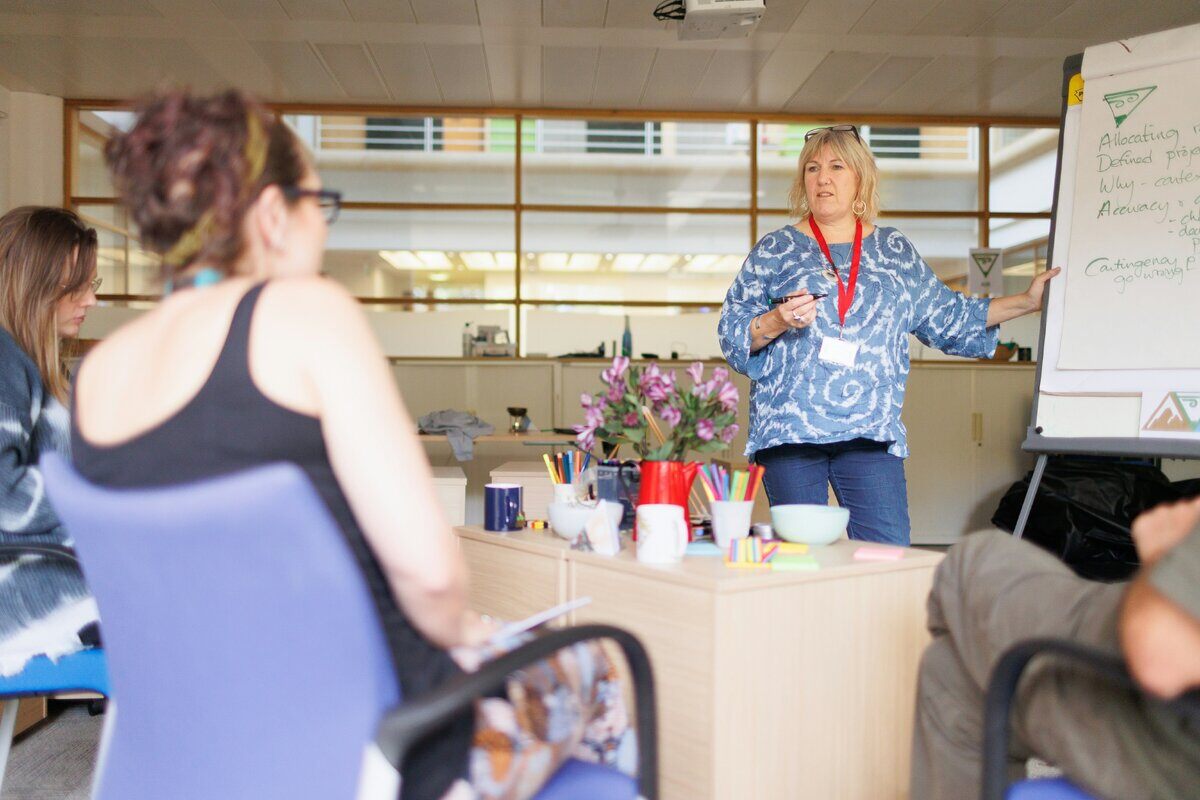
Webinar Strategy Template: A Visual Framework For Designing Virtual Learning Experiences
In previous posts, we've covered the history of webinars both culturally and technologically.
We've talked about webinar strategy, where they excel and where they fall short in their capacity as a platform for information sharing, as well as best practices for putting a great webinar together.
Here, we wish to briefly cover the state of webinars as it exists today.
The purpose of this is to give you a precise vision of this technology so that you can use it effectively, know what it is capable of, and determine whether or not webinars are the best strategy for your teaching, outreach, and information-sharing needs.
Current State of Webinars
Webinars, as a technology, have been through some significant ups and downs since the year 2000.
Up until the early 2010s, it was considered to be the premiere method of information-sharing.
This is especially true in academic and corporate settings.
Around 2013, when free services like Skype and Google Hangouts became common, thought leaders started steering us away from webinar platforms.
Just short of the pandemic in 2020, Forbes and their peers were calling the webinar dead.
We've said it before and we're saying it again, but the response to the pandemic breathed new life into the webinar as a leading way of sharing and distributing information.
Today, webinars are more popular and more powerful than ever!
Not unlike the recession of 2008, the response to the pandemic drove people away from traditional corporate workplaces.
It forced people to find new ways to be productive. In 2008, the great shift was toward self-education, and it led to the rise of the online classroom.
The pandemic had a similar effect, bolstering the usefulness of the online classroom.
With so many people looking to use information technology to remain in touch and maintain their bottom lines, webinars were there to save the day.
The result is that the webinar is stronger than ever before.
It is inexpensive, rich in features, and highly customizable.
Most importantly, it opens up a major bottleneck in information-sharing.
Webinars have become an embedded part of the culture. Just as Twitter has become the Public Square and Facebook is the place for friends and families, the webinar is how organizations talk to their audiences, workforce, partners, and each other.
The Rationale For Webinar Strategy
The key to running a successful webinar or webinar series is to plan the event and presentations strategically.
What does that mean?
Consider traditional television commercials.
A TV commercial is designed to appeal to a specific type of person.
That is to say that a TV ad appeals to an age group, gender, ethnicity, career or trade, income bracket, likes and dislikes, and specific pain points.
In other words, the target audience for a TV commercial is a marketing demographic.
With some webinars, it's a little bit more straightforward, especially if your audience is a student population or your workforce.
In these cases, you have a skill set list or educational goals that need to be related regardless of who the audience is.
When your webinar has a commercial purpose and is part of a marketing outreach campaign, or if it is propositional in nature, then marking demographics becomes relevant.
This is the reason we have developed design strategies, best practices, and tools.
Beyond the similarity of webinars to TV ads, we also make use of strategy because there are so many more options.
Your webinar style and strategy options are numerous and include presentation style, type, interactivity, branding, and much more.
A good webinar strategy takes all of these things, and more, into consideration at the drawing board phase.
Now, let's talk more about the design process.
Designing The Learning Experience
Building out a webinar plan for online learning can be a challenge, but there are well-established, foundational best practices that you can depend on during the drafting process.
This is a practice sometimes referred to as instructional design.
With the right guidance and design options, you'll be able to build out your learning experience fully, accomplish your goals, and help keep your learners motivated throughout the process.
But first, your course material needs at least five foundational strategy basics.
Learning Experience Design Strategy Basics
1. Select Quality Resources
The sources you use for your information need to be authoritative and verifiable.
That is to say, information should come from expert sources that are provably qualified, trustworthy, and useful.
2. Know The Scope Of Your Curriculum
Your initial curriculum plan should include every step along the educational pathway.
If, for example, you are training a team of home healthcare attendants to perform a range of motion exercises, then your course should include basic stretching, all the way through to considerations for those with certain conditions, and everything in between.
3. Have A Robust File Management Strategy
Any organization needs to be able to process changes.
When a learner becomes competent in a given task, they need to be credited and their accreditation needs to be logged.
Test results should be recorded reliably and in a way that can be easily rediscovered.
Using an offline file system can be best for reliability and security reasons.
4. Employ Meaningful Skill Review Practices
You need to be able to assess progress accurately, meaningfully, and reliably. Testing and demonstrations should show competence in reality, above and beyond the simulation level. Some webinar design interfaces come with an authoring tool meant to show that the work is original and produced by the student who turns it in. But these are often not enough to prove competence. Therefore, more traditional skills testing (done online) is also needed.
5. Check Your Design Before Deployment
Before initiating course materials, it is best to do a dry run-through with a test group.
This can be time-consuming, but it's the best way to discover any bugs in your learning experience design.

Learning Experience Strategy Canvas
The Learning Experience Strategy Canvas is very similar to the Learning Experience Canvas.
The difference is that while the LX Canvas helps you format your complete Learning Experience, the LX Strategy Canvas helps you in the more preliminary design phase.
What Is It?
The LX Strategy Canvas helps you build your LX strategy before going deeper into the design stage.
Every training or learning environment needs to draw in the right learners, develop their abilities in the desired fashion, and motivate them to perform.
It needs to offer a values-based culture, and in the case of corporate training, it needs to build on the brand.
The LX Strategy Canvas sets forth a distinct and easy-to-understand structure for the drafting process.
By going through the LX Strategy Canvas process, you can easily move into the design process with a clear vision of how to move forward.
You can think of it as similar to writing an outline before completing an in-depth essay.
It gives you boxes to fill in and allows you the opportunity to make sure everything works together and appears in optimal order.
Why Use The LX Strategy Canvas?
After working through your LX Strategy Canvas, using LX Canvas to put the finishing touches on your webinar strategy will be a breeze.
LXC will guide you through the design process, help you make key design choices based on established best webinar design practices, and make sure your presentations are on point, relevant, and engaging.
Now, let's take a closer look at how LX Canvas can help turn your webinar series into a winning learning experience.
How Does It Help?
LX Canvas takes your work in the strategy canvas and makes it easy for you to turn your rough outline into a transformative learning experience.
The LXC format is built to address the LXD strategy basics to ensure your presentations and interactive elements comprise a complete and effective teaching/learning environment.
LXC: Five Design Questions
This will take you through the ways that incorporating Goals, People, Places, Strategy, and Resources into your learning environment will ensure your webinars have the desired effect.
As you answer these questions, you will build out the basis for your complete webinar creation process.
Sure, it may take some getting used to.
But once you've got it down, you'll find that designing your desired learning experience is a snap!
1. How do we promote practice in the learning experience?
Practice makes perfect!
Promoting practice may be the single most important element of any good teaching webinar, but promoting practice means more than just offering the opportunity to practice.
It means making the act of engaging with practice materials fun, satisfying, and effective.
Your learners should be motivated to interact with your practice materials through compelling language, layouts, and results-driven rewards.
2. How do we intentionally design feedback moments in the learning experience?
A key way to ensure that practice sessions are compelling is by strategically incorporating positive feedback.
Your learners need feedback that shows them their errors in a way that is not discouraging. They also need to be made aware of their successes in a way that is clear and rewarding.
The tone, timing, and form these feedback moments take will be critical to the success of your LXD.
3. How do we have a dialogue?
Dialogue can take many forms in a teaching webinar.
It can be direct person-to-person interaction, video presentations, written material, interactive game-like experiences, and more.
The nature of dialogue is that it offers complete answers tailored to the needs of the student and the nature of the question.
Dialogue should be direct, instructional, and delivered to meet the student's learning style.
As someone with a desire to teach, you already have the motivation to make dialogue work.
The question is, how and where do you incorporate it into your materials? LXC can help with this!
4. What information is delivered?
Naturally, the information delivered in your learning experience should be to the point and relevant.
It should be presented in a way that your learners can understand and use to achieve their goals.
Finally, the sources of your information should be authoritative.
That way, the student can use these sources as avenues for further study on their own time, and do so with confidence.
5. Emphasize value proposition
Finally, how does your learning/teaching webinar promote the end-value proposition? I
n other words, how does it forward the needs of the company, deliver on the promise of the course description, or promote the success of the relevant brand?
Students should walk away with the skills and knowledge they need to become agents of the end-value proposition or be motivated to make the desired decision.
The final value of your webinar learning experience will depend on how well it meets this goal.
Conclusion
To learn more, a great place to start is by downloading LX Canvas Playbook for free.
The key to creating a great learning experience is to make sure it is effective and engaging.
Through robust communication, available learning resources, gamification, meaningful rewards, and documentation, LXC will give you the keys to crafting outstanding learning experiences.
Get access to our Webinar Strategy Template, and supercharge your teaching webinars today!






